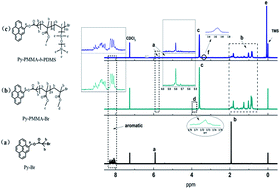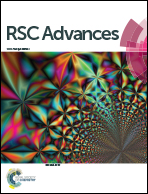Non-covalent functionalization of graphene oxide by pyrene-block copolymers for enhancing physical properties of poly(methyl methacrylate)†
Abstract
Pyrene-functionalized poly(methyl methacrylate)-block-polydimethylsiloxane (Py-PMMA-b-PDMS) copolymers were synthesized via activators regenerated by an electron transfer atom transfer radical polymerization (ARGET ATRP) method and further used to functionalize graphene oxide (GO) through the π–π interaction between pyrene and the carbon sheets. The modification efficiency of the non-covalently functionalized GO (GO@Py-PMMA-b-PDMS) particles was evaluated by studying their effects on the mechanical, optical and thermal properties of the PMMA. With incorporation of 0.05 wt% GO@Py-PMMA-b-PDMS, the tensile strength, Young's modulus, elongation at break and toughness of PMMA were increased by 23%, 54%, 117%, and 218%, respectively, showing simultaneously reinforcing and toughening effects of the functionalized GO particles; the initial decomposition temperature of PMMA increased by 11 °C from 349 °C to 360 °C; and the haze value of PMMA increased from 2.1% to 16.8%; the refractive index of PMMA varied from 1.48 to 1.51. This improvement in the physical properties of PMMA can be attributed to the homogeneous dispersion and enhanced interfacial adhesion between GO@Py-PMMA-b-PDMS and PMMA. This work demonstrates the feasibility of using GO@Py-PMMA-b-PDMS as a modifier for simultaneously improving the mechanical, optical and thermal properties of PMMA for potential organic light-emitting diodes and organic photovoltaics applications.


 Please wait while we load your content...
Please wait while we load your content...